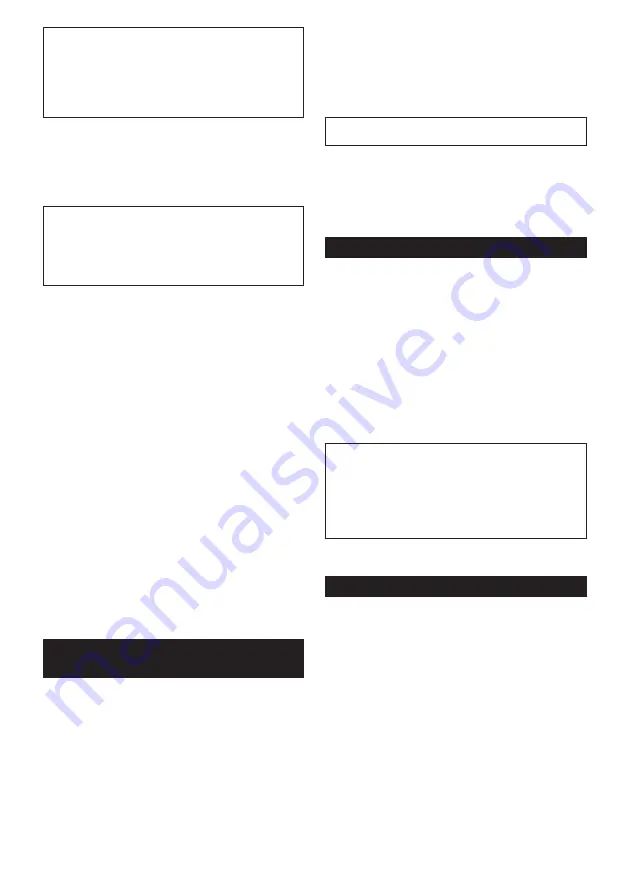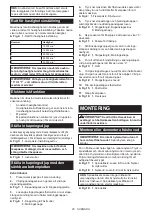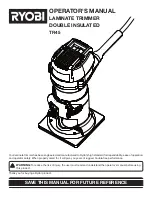
18
ENGLISH
NOTE:
Before cutting on the actual workpiece, it is
recommended to make a sample cut. The proper feed
speed depends on the trimmer bit size, the kind of
workpiece, and depth of cut. Moving the tool forward
too fast may cause a poor quality of cut, or damage
to the bit or motor. Moving the tool forward too slowly
may burn and mar the cutting surface.
When using the trimmer shoe, the straight guide, or the
trimmer guide, be sure to keep it on the right side in the
feed direction. This will help to keep it flush with the side
of the workpiece.
►
Fig.41:
1.
Trimmer bit
2.
Workpiece
3.
Straight
guide
NOTICE:
Since excessive cutting may cause
overload of the motor or difficulty in controlling
the tool, the depth of cut should not be more than
3 mm at a pass when cutting grooves.
When you
wish to cut grooves more than 3 mm deep, make
several passes with progressively deeper bit settings.
Using the straight guide
Optional accessory
1.
Assemble the straight guide with the bolt and the
wing nut.
►
Fig.42:
1.
Bolt
2.
Wing nut
2.
Attach the straight guide to the trimmer base with
the clamp screw.
►
Fig.43:
1.
Clamp screw
3.
Loosen the wing nut on the straight guide and
adjust the distance between the bit and the straight
guide. At the desired distance, tighten the wing nut.
►
Fig.44:
1.
Wing nut
4.
Move the tool with the straight guide flush with the
side of the workpiece.
►
Fig.45
If the distance (A) between the side of the workpiece
and the cutting position is too wide for the straight
guide, or if the side of the workpiece is not straight, the
straight guide cannot be used.
In this case, firmly clamp a straight board to the work
-
piece and use it as a guide against the trimmer base.
Feed the tool in the direction of the arrow.
►
Fig.46
Using the straight guide for circular
work
For circular work, assemble the straight guide as shown
in the figures. The minimum and maximum radius of
circles to be cut (distance between the center of circle
and the center of bit) are as follows:
•
Minimum: 70 mm
•
Maximum: 221 mm
For cutting circles between 70 mm and 121 mm in
radius.
►
Fig.47:
1.
Center hole
For cutting circles between 121 mm and 221 mm in
radius.
►
Fig.48:
1.
Center hole
NOTE:
Circles between 172 mm and 186 mm in
radius cannot be cut using this guide.
Align the center hole in the straight guide with the cen
-
ter of the circle to be cut. Drive a nail less than 6 mm
in diameter into the center hole to secure the straight
guide. Pivot the tool around the nail in the clockwise
direction.
►
Fig.49:
1.
Nail
2.
Center hole
Using the templet guide
Optional accessory
The templet guide allows for repetitive cut with templet
patterns by using a templet.
1.
Loosen the screws on the base plate, and then
remove the base plate from the trimmer base.
2.
Place the templet guide on the base, and then
attach the base plate by tightening the screws.
►
Fig.50:
1.
Base plate
2.
Templet guide
3.
Place the tool on the templet and move the tool
with the templet guide sliding along the side of the
templet.
►
Fig.51
NOTE:
The actual cut size on the workpiece is slightly
different from the templet. The difference is the dis
-
tance (X) between the trimmer bit and the outside of
the templet guide. The distance (X) can be calculated
by using the following equation:
Distance (X) = (outside diameter of templet guide -
trimmer bit diameter) / 2
►
Fig.52:
1.
Trimmer bit
2.
Templet guide
3.
Distance
(X)
4.
Outside diameter of templet guide
Using the trimmer guide
Optional accessory
The trimmer guide allows for trimming the curved side
like veneers for furniture by moving the guide roller
along the side of the workpiece.
►
Fig.53
1.
Loosen the clamp screw, then install the trimmer
guide on the trimmer base, and then tighten the clamp
screw.
►
Fig.54:
1.
Clamp screw
2.
Loosen the clamp screw and adjust the distance
between the trimmer bit and the trimmer guide by turn-
ing the adjusting screw (1 mm per turn). At the desired
distance, tighten the clamp screw to secure the trimmer
guide.
►
Fig.55:
1.
Adjusting screw
2.
Clamp screw
3.
Move the tool with the guide roller riding the side
of the workpiece.
►
Fig.56:
1.
Workpiece
2.
Bit
3.
Guide roller
Summary of Contents for DRT50ZJX2
Page 2: ...1 2 3 Fig 1 1 2 Fig 2 2 1 Fig 3 1 Fig 4 2 1 Fig 5 1 Fig 6 1 2 Fig 7 2 3 1 Fig 8 2 ...
Page 3: ...1 2 Fig 9 2 3 1 Fig 10 1 Fig 11 1 2 Fig 12 1 Fig 13 1 Fig 14 1 Fig 15 1 Fig 16 3 ...
Page 4: ...1 2 3 4 5 Fig 17 1 2 3 1 4 Fig 18 1 Fig 19 1 Fig 20 1 Fig 21 1 2 Fig 22 Fig 23 4 ...
Page 5: ...1 Fig 24 1 2 3 Fig 25 1 2 Fig 26 1 2 3 Fig 27 1 Fig 28 1 Fig 29 2 1 Fig 30 5 ...
Page 6: ...1 Fig 31 1 Fig 32 1 2 3 Fig 33 1 2 3 Fig 34 2 1 Fig 35 1 Fig 36 1 2 Fig 37 1 2 3 Fig 38 6 ...
Page 7: ...Fig 39 Fig 40 1 3 2 Fig 41 2 1 Fig 42 1 Fig 43 1 Fig 44 Fig 45 A Fig 46 7 ...
Page 8: ...1 Fig 47 1 Fig 48 2 1 Fig 49 1 2 Fig 50 Fig 51 1 2 3 4 Fig 52 Fig 53 1 Fig 54 8 ...
Page 9: ...1 2 Fig 55 1 2 3 Fig 56 1 Fig 57 1 2 Fig 58 Fig 59 1 2 Fig 60 2 1 Fig 61 9 ...
Page 10: ...1 2 Fig 62 1 2 3 4 Fig 63 1 Fig 64 Fig 65 1 2 Fig 66 Fig 67 Fig 68 A Fig 69 10 ...
Page 87: ...87 ...
















































